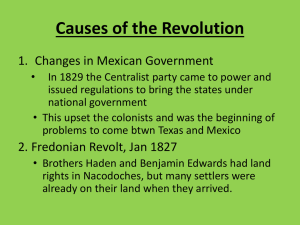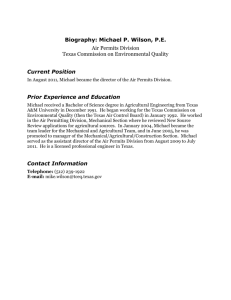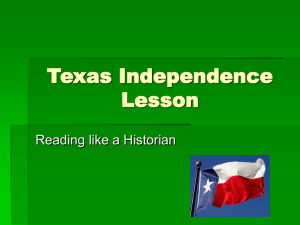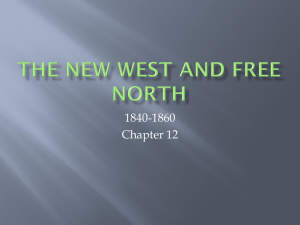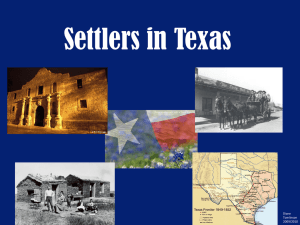Grade 7_2nd 6 Weeks_Week 4 October 26
advertisement
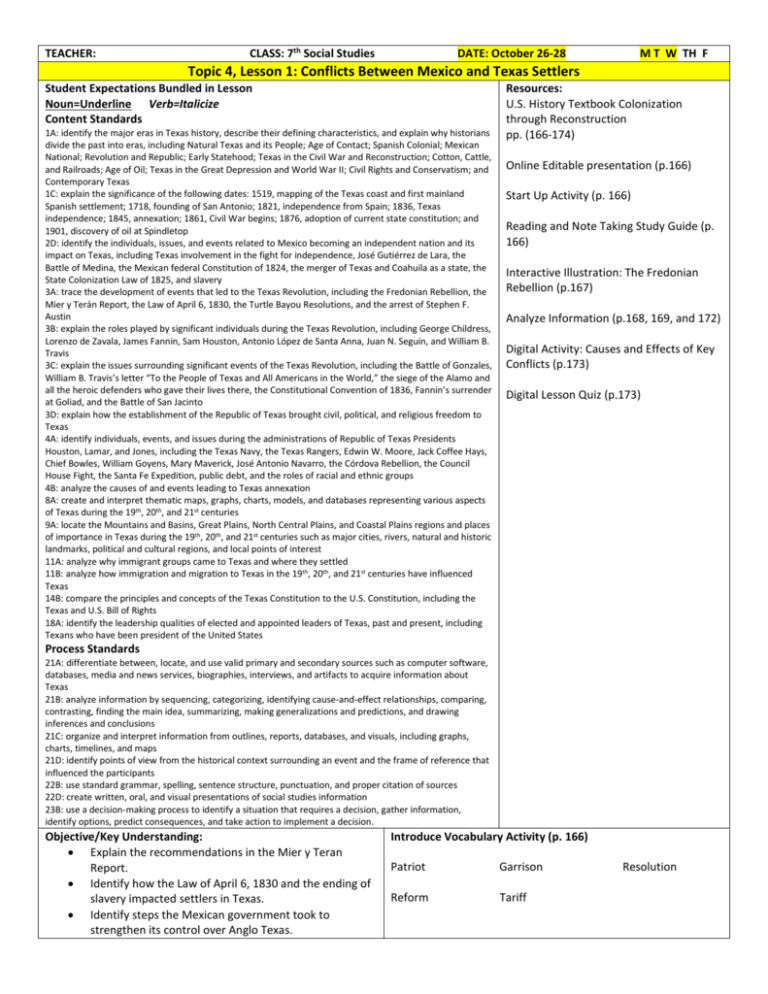
TEACHER: CLASS: 7th Social Studies DATE: October 26-28 M T W TH F Topic 4, Lesson 1: Conflicts Between Mexico and Texas Settlers Student Expectations Bundled in Lesson Noun=Underline Verb=Italicize Content Standards 1A: identify the major eras in Texas history, describe their defining characteristics, and explain why historians divide the past into eras, including Natural Texas and its People; Age of Contact; Spanish Colonial; Mexican National; Revolution and Republic; Early Statehood; Texas in the Civil War and Reconstruction; Cotton, Cattle, and Railroads; Age of Oil; Texas in the Great Depression and World War II; Civil Rights and Conservatism; and Contemporary Texas 1C: explain the significance of the following dates: 1519, mapping of the Texas coast and first mainland Spanish settlement; 1718, founding of San Antonio; 1821, independence from Spain; 1836, Texas independence; 1845, annexation; 1861, Civil War begins; 1876, adoption of current state constitution; and 1901, discovery of oil at Spindletop 2D: identify the individuals, issues, and events related to Mexico becoming an independent nation and its impact on Texas, including Texas involvement in the fight for independence, José Gutiérrez de Lara, the Battle of Medina, the Mexican federal Constitution of 1824, the merger of Texas and Coahuila as a state, the State Colonization Law of 1825, and slavery 3A: trace the development of events that led to the Texas Revolution, including the Fredonian Rebellion, the Mier y Terán Report, the Law of April 6, 1830, the Turtle Bayou Resolutions, and the arrest of Stephen F. Austin 3B: explain the roles played by significant individuals during the Texas Revolution, including George Childress, Lorenzo de Zavala, James Fannin, Sam Houston, Antonio López de Santa Anna, Juan N. Seguín, and William B. Travis 3C: explain the issues surrounding significant events of the Texas Revolution, including the Battle of Gonzales, William B. Travis’s letter “To the People of Texas and All Americans in the World,” the siege of the Alamo and all the heroic defenders who gave their lives there, the Constitutional Convention of 1836, Fannin’s surrender at Goliad, and the Battle of San Jacinto 3D: explain how the establishment of the Republic of Texas brought civil, political, and religious freedom to Texas 4A: identify individuals, events, and issues during the administrations of Republic of Texas Presidents Houston, Lamar, and Jones, including the Texas Navy, the Texas Rangers, Edwin W. Moore, Jack Coffee Hays, Chief Bowles, William Goyens, Mary Maverick, José Antonio Navarro, the Córdova Rebellion, the Council House Fight, the Santa Fe Expedition, public debt, and the roles of racial and ethnic groups 4B: analyze the causes of and events leading to Texas annexation 8A: create and interpret thematic maps, graphs, charts, models, and databases representing various aspects of Texas during the 19th, 20th, and 21st centuries 9A: locate the Mountains and Basins, Great Plains, North Central Plains, and Coastal Plains regions and places of importance in Texas during the 19th, 20th, and 21st centuries such as major cities, rivers, natural and historic landmarks, political and cultural regions, and local points of interest 11A: analyze why immigrant groups came to Texas and where they settled 11B: analyze how immigration and migration to Texas in the 19th, 20th, and 21st centuries have influenced Texas 14B: compare the principles and concepts of the Texas Constitution to the U.S. Constitution, including the Texas and U.S. Bill of Rights 18A: identify the leadership qualities of elected and appointed leaders of Texas, past and present, including Texans who have been president of the United States Resources: U.S. History Textbook Colonization through Reconstruction pp. (166-174) Online Editable presentation (p.166) Start Up Activity (p. 166) Reading and Note Taking Study Guide (p. 166) Interactive Illustration: The Fredonian Rebellion (p.167) Analyze Information (p.168, 169, and 172) Digital Activity: Causes and Effects of Key Conflicts (p.173) Digital Lesson Quiz (p.173) Process Standards 21A: differentiate between, locate, and use valid primary and secondary sources such as computer software, databases, media and news services, biographies, interviews, and artifacts to acquire information about Texas 21B: analyze information by sequencing, categorizing, identifying cause-and-effect relationships, comparing, contrasting, finding the main idea, summarizing, making generalizations and predictions, and drawing inferences and conclusions 21C: organize and interpret information from outlines, reports, databases, and visuals, including graphs, charts, timelines, and maps 21D: identify points of view from the historical context surrounding an event and the frame of reference that influenced the participants 22B: use standard grammar, spelling, sentence structure, punctuation, and proper citation of sources 22D: create written, oral, and visual presentations of social studies information 23B: use a decision-making process to identify a situation that requires a decision, gather information, identify options, predict consequences, and take action to implement a decision. Objective/Key Understanding: Explain the recommendations in the Mier y Teran Report. Identify how the Law of April 6, 1830 and the ending of slavery impacted settlers in Texas. Identify steps the Mexican government took to strengthen its control over Anglo Texas. Introduce Vocabulary Activity (p. 166) Patriot Garrison Reform Tariff Resolution Identify reasons Texas settlers were unhappy with the Mexican government. Trace how events including the Turtle Bayou Resolutions led to the Texas Revolution. Describe the first battle in which Texan settlers defeated the Mexican government. Informal Assessment Questions 1-5 (p. 174) How did Mexico try to strengthen control over Texas? How did the issue of slavery become entangled in the politics leading to the Texas revolution? Why did the settlers of Texas decide to arm themselves? What did the settlers of Texas declare in the Turtle Bayou Revolutions? How did growing tensions between Mexico and Texas lead some to be concerned about an outright rebellion? Stop & Check for Understanding—High Level Questions Summarize Mier y Teran’s observations of the Texas history. List the changes that the Mexican government tried to impose on Texas. What was the result of John Austin’s attack at Velasco? Small Group Purposeful Talk Question Stems Texas Settlers Concern Mexico (p. 167-169) What caused Mexican leaders to send General Mier y Teran north? What was the effect of his journey? What effect did Mier y Teran Report have? What effect did the Law of April 6, 1830 have? Other Changes in Mexico and Texas (p. 169-171) Discuss that in 1831, a group of Anglo settlers, angered over Mexican land policies, formed a new town called Liberty. Several leaders of the Texas Revolution lived and worked in Liberty over the following years. How do you think the people of Texas felt when Captain Juan Davis Bradburn, under General Mier y Teran, arrested the land officials and destroyed the town? Trouble at Anahuac (p.171-174) Discuss that the Turtle Bayou Resolution and the first bloodshed of the Texas Revolution at Velasco were related. A party led by John Austin had departed Anahuac to retrieve cannon for an attack on the garrison. They planned to take the guns down to Brazos River. Floating past the Mexican fort at Velasco. Austin refused orders to stop and fired the fort. The Texans were victorious in the ensuing fight. Discuss that the number of casualties at the Battle Velasco was about 7 Texans killed and 14 wounded and 5 Mexicans killed and 16 wounded. Does this seem like a big and important battle to you? Online Resources, Analyzing Maps and Charts & Digital Activity Online Editable Presentation (p. 166) Use the Editable Presentation found on the Digital Course to present the main ideas for this lesson Start Up Activity (p. 166) Project the Start Up Activity (p. 166). Review the Confrontation Anahuac where angry Texas settlers confronted Mexican officials. Give students time to think and write their paragraphs in response to these questions: What can you conclude about the cause of the conflict? What predictions can you make about its outcome? Reading and Note Taking Study Guide (p. 166) Students can preview Key Terms and Academic Vocabulary using the Interactive Reading Notebook on the Digital Course or preview of the lesson in the Reading and Note taking Study Guide. Interactive Illustration (p.167) Project the Interactive Illustration: The Fredonian Rebellion (p.167). Click the numbered circles to learn more about the Fredonian Rebellion. The number of Americans coming to Texas troubled Manuel de Mier y Teran. He urged Mexico to take strong steps to stop a possible U.S. acquisition of Texas. What main issue concerned Mier y Teran? Analyze Information (p. 168) Review the graphic on page 168. Which parts to the Law of April 6, 1830 were most likely to anger Anglo settlers in Texas? Why? Analyze Information (p. 169) Review the graphic on page 169. How did encouraging European settlers to come to Texas help Mexico maintain control over the region? Analyze Information (p. 172) Review the graphic on page 172. What was the main purpose of the Turtle Bayou Resolutions? Digital Activity: Causes and Effects of Key Conflicts (p. 173) Project the Digital Activity: Causes and Effects of Key Conflicts (p. 173). Have students complete the graphic organizer of causes and effects of conflicts between Mexican officials and Texas settlers. Tell them to annotate their graphic organizers with dates. Digital Lesson Quiz (p. 173) Assign the Digital Lesson Quiz (p. 148). Discuss with the class, In Conflicts Between Mexico and Texas Settlers, you traced the development of events that led to the Texas Revolution. Do you think any of the conflicts between Texans and the Mexican government could have been handled better by wither side? Explain. How do you think the Mexican government will react to the bloodshed at Velasco? Lesson Plan *Have students preview the lesson objectives and the list of key terms (p.166). Use the Editable Presentation found on the digital course to present the main ideas of the lesson (p. 166). Engage Explore Explain Elaborate Start Up Activity (p. 166) Project the Start Up Activity (p. 166). Review the Confrontation Anahuac where angry Texas settlers confronted Mexican officials. Give students time to think and write their paragraphs in response to these questions: What can you conclude about the cause of the conflict? What predictions can you make about its outcome? Tell students that in this lesson they will be learning about the development of events that led to the Texas Revolution, including the Mier y Tern Report, the Law of April 6, 1830, and the Turtle Bayou Resolutions. Tell them that events about which they will learn are significant steps toward historic changes that resulted from the Texas Revolution. *Divide the class into groups. Each group is to read a section and be prepared to discuss and share findings with the class. Texas Settlers Concern Mexico (p.167-169) Other Changes in Mexico and Texas (p.169-171) Trouble in Anahuac (p.171-174) Students are to read assigned sections and use the Note Taking Study Guide to help them take notes and understand the text as they read. Tell students that in this lesson they will be learning about the development of events that led to the Texas Revolution, including the Mier y Tern Report, the Law of April 6, 1830, and the Turtle Bayou Resolutions. Tell them that events about which they will learn are significant steps toward historic changes that resulted from the Texas Texas Settlers Concern Mexico (p.167-169) When Mexican officers and troops, along with volunteers from Austin’s colony, reached Nacogdoches in January 31, 1827, the revolutionaries fled across the Sabine River into the U.S. The Fredonian Rebellion was over. Other Changes in Mexico and Texas (p.169-171) The Mexican government tried to strengthen its control over Texas. However, the situation worsened. Trouble in Anahuac (p.171-174) Bradburn’s appearance at Liberty was not his first visit to Texas. Earlier he had set up a garrison and tax collection station at Anahuac. The site he chose overlooked the mouth of the Trinity River. A small town called Perry’s Point was already there. Mexican officials had renamed it Anahuac after the ancient Aztec capital as part of their effort to better integrate Texas into the young Mexican Nation. *Guided Reading and Discussion Questions See Small Group Purposeful Talk Question Stems from the previous page for this portion of the lesson. *Analyzing Maps and Charts & Digital Activity See Online Resources from the previous page for this portion of the lesson. *Topic of Inquiry Examine primary source documents to answer the following questions. How did Anglo and Tejano Texans justify revolution and set up their new government? Examining why Texans went to war will contribute to students understanding the Essential Question When is war justified? *Assign the Digital Lesson Quiz for this lesson (p. 173). Teachers can also opt to have students demonstrate mastery by responding to the following questions on paper: Evaluate TEACHER: How did Mexico try to strengthen control over Texas? How did the issue of slavery become entangled in the politics leading to the Texas revolution? Why did the settlers of Texas decide to arm themselves? What did the settlers of Texas declare in the Turtle Bayou Revolutions? How did growing tensions between Mexico and Texas lead some to be concerned about an outright rebellion? CLASS: 7th Social Studies DATE: October 29-30 M T W TH F Topic 4 , Lesson 2 : From Reform to Revolution Student Expectations Bundled in Lesson Noun=Underline Verb=Italicize Content Standards 1A: identify the major eras in Texas history, describe their defining characteristics, and explain why historians divide the past into eras, including Natural Texas and its People; Age of Contact; Spanish Colonial; Mexican National; Revolution and Republic; Early Statehood; Texas in the Civil War and Reconstruction; Cotton, Cattle, and Railroads; Age of Oil; Texas in the Great Depression and World War II; Civil Rights and Conservatism; and Contemporary Texas 1C: explain the significance of the following dates: 1519, mapping of the Texas coast and first mainland Spanish settlement; 1718, founding of San Antonio; 1821, independence from Spain; 1836, Texas independence; 1845, annexation; 1861, Civil War begins; 1876, adoption of current state constitution; and 1901, discovery of oil at Spindletop 2D: identify the individuals, issues, and events related to Mexico becoming an independent nation and its impact on Texas, including Texas involvement in the fight for independence, José Gutiérrez de Lara, the Battle of Medina, the Mexican federal Constitution of 1824, the merger of Texas and Coahuila as a state, the State Colonization Law of 1825, and slavery 3A: trace the development of events that led to the Texas Revolution, including the Fredonian Rebellion, the Mier y Terán Report, the Law of April 6, 1830, the Turtle Bayou Resolutions, and the arrest of Stephen F. Austin 3B: explain the roles played by significant individuals during the Texas Revolution, including George Childress, Lorenzo de Zavala, James Fannin, Sam Houston, Antonio López de Santa Anna, Juan N. Seguín, and William B. Travis 3C: explain the issues surrounding significant events of the Texas Revolution, including the Battle of Gonzales, William B. Travis's letter "To the People of Texas and All Americans in the World," the siege of the Alamo and all the heroic defenders who gave their lives there, the Constitutional Convention of 1836, Fannin's surrender at Goliad, and the Battle of San Jacinto 3D: explain how the establishment of the Republic of Texas brought civil, political, and religious freedom to Texas 4A: identify individuals, events, and issues during the administrations of Republic of Texas Presidents Houston, Lamar, and Jones, including the Texas Navy, the Texas Rangers, Edwin W. Moore, Jack Coffee Hays, Chief Bowles, William Goyens, Mary Maverick, José Antonio Navarro, the Córdova Rebellion, the Council House Fight, the Santa Fe Expedition, public debt, and the roles of racial and ethnic groups 4B: analyze the causes of and events leading to Texas annexation 8A: create and interpret thematic maps, graphs, charts, models, and databases representing various aspects of Texas during the 19th, 20th, and 21st centuries 9A: locate the Mountains and Basins, Great Plains, North Central Plains, and Coastal Plains regions and places of importance in Texas during the 19th, 20th, and 21st centuries such as major cities, rivers, natural and historic landmarks, political and cultural regions, and local points of interest 11A: analyze why immigrant groups came to Texas and where they settled 11B: analyze how immigration and migration to Texas in the 19th, 20th, and 21st centuries have influenced Texas 14B: compare the principles and concepts of the Texas Constitution to the U.S. Constitution, including the Texas and U.S. Bill of Rights 18A: identify the leadership qualities of elected and appointed leaders of Texas, past and present, including Texans who have been president of the United States Process Standards 21A: differentiate between, locate, and use valid primary and secondary sources such as computer software, databases, media and news services, biographies, interviews, and artifacts to acquire information about Texas 21B: analyze information by sequencing, categorizing, identifying cause-and-effect relationships, comparing, contrasting, finding the main idea, summarizing, making generalizations and Resources: U.S. History Textbook Colonization through Reconstruction pp. (175-182) Online Editable presentation (p.175) Start Up Activity (p. 175) Reading and Note Taking Study Guide (p. 175) Analyze Charts, Information, (p. 176, 178, and 180) Interactive Timeline: Building to the Texas Revolution (p.179) Active Classroom (p.180) Digital Activity: When is War Justified? (p.182) Digital Lesson Quiz (p.182) predictions, and drawing inferences and conclusions 21C: organize and interpret information from outlines, reports, databases, and visuals, including graphs, charts, timelines, and maps 21D: identify points of view from the historical context surrounding an event and the frame of reference that influenced the participants 22B: use standard grammar, spelling, sentence structure, punctuation, and proper citation of sources 22D: create written, oral, and visual presentations of social studies information 23B:use a decision-making process to identify a situation that requires a decision, gather information, identify options, predict consequences, and take action to implement a decision Objective/Key Understanding: Introduce Vocabulary Activity (p. 175) Federal system Central Government Delegate Explain the role of Antonio Lopez de Santa Anna in the Mexican Civil War. Ayuntamiento Legislature Dictator Describe the goals of the delegates to the Conventions of 1832 and 1833. Committees of Safety and Correspondence Understand how suspending the Mexican Constitution of 1824 impacted Mexico and Texas. Understand how the arrest of Stephen F. Austin caused relations between Texas and Mexico to worsen . Informal Assessment Questions 1-5 (p. 182) Which aspect of a federalist government did Texas like? What was wrong with the Convention of 1832? Why was Stephen F. Austin’s arrest troubling? In what sense was Santa Anna influenced by the Catholic Church? What were the committees of safety and correspondence? Stop & Check for Understanding—High Level Questions Why did the settlers of Texas prefer a federalist form of government to a centralist government? Why were the Conventions of 1832 and 1833 significant? How did the Catholic Church play a role in increasing tensions between Mexico and Texas? Even Santa Anna’s drastic actions failed to push many Texas settlers to war. Why were the demands of Cos the straw? Small Group Purposeful Talk Question Stems Unrest in Mexico (p.176-177) Assign a pair of students the task of summarizing the role of de Santa Anna in the Mexican civil war. Give them time to prepare their summary and then present it in an appropriate form to their fellow students. The Conventions of 1832 and 1833 (p.177-178) Present the events below in random order and hav students sequence them properly. - Mexican civil war begins - Convention of 1832 - Santa Anna victorious - Convention of 1833 - Stephen F. Austin sets out for Mexico City Austin in Mexico City (p.179-180) Have students explain how suspending the Mexican constitution of 1824 impacted Mexico and Texas. How do you think Texans will react to Santa Anna’s actions? Reaction in Texas (p.181-182) Remind students that Stephen F. Austin had been jailed in Mexico for almost a year and guarded for six months before he was able to return to Texas. He was never charged with a crime. How did his arrest contribute to the development of events that led to the Texas Revolution? Online Resources, Analyzing Maps and Charts & Digital Activity Online Editable Presentation (p. 175) Use the Editable Presentation found on the Digital Course to present the main ideas for this lesson Start Up Activity (p. 175) Project the Start Up Activity (p. 175). Discuss with students: What words or phrases would you use to describe the mood in San Antonio? Reading and Note Taking Study Guide (p. 175) Students can preview Key Terms and Academic Vocabulary using the Interactive Reading Notebook on the Digital Course or preview of the lesson in the Reading and Note taking Study Guide Analyze Charts (p. 176) Review the chart on page 176. How would Texans likely have benefited from a Federalist government? Analyze Information (p. 178) Review the graphic, Coahula y Tejas 1833, on page 178. How might the changing population of Texas have increased settlers’ frustration with the Mexican government? Why are the circles different sizes and colors? Interactive Time: Building to the Texas Revolution (p.179) With student input, place each tile in its correct place on the timeline. Analyze Information (p. 180) Review the table, The Changing Views of Santa Anna, on page 180. What key differences existed among Texas’s three most populated areas? Digital Activity: When is War Justified? (p. 182) Project the Digital Activity: When is War Justified? (p. 182). As a class, generate an image-a timeline, a cause and effect chain, a series of drawings-that traces the development of events that led to the Texas Revolution. Do you think the Texans were justified in their decision given the events that came just before? Why or Why not? Digital Lesson Quiz: (p. 182) Assign the Digital Lesson Quiz (p. 182). Discuss with the class: In the class, From Reform to Revolution, you traced the development of events that led to the Texas Revolution. Do you think conflict would have been avoided if Texans were given their own state in Mexico? Why do you think this? What drove Stephen F. Austin to say, “War is our only resource”? Lesson Plan *Have students preview the lesson objectives and the list of key terms (p.175). Use the Editable Presentation found on the digital course to present the main ideas of the lesson (p. 175). Engage Explore Explain Elaborate Start Up Activity (p. 175) Project the Start Up Activity (p. 175). Discuss with students: What words or phrases would you use to describe the mood in San Antonio? *Tell students that in this lesson they will trace the development of events that led to the Texas Revolution, including the arrest of Stephen F. Austin. *Divide the class into groups. Each group is to read a section and be prepared to discuss and share findings with the class. Unrest in Mexico (p.176-177) The Conventions of 1832 and 1833 (p.177-178) Austin in Mexico City (p.179-180) Reaction in Texas (p.181-182) *Students are to read assigned sections and use the Note Taking Study Guide to help them take notes and understand the text as they read. *Tell students that in this lesson they will trace the development of events that led to the Texas Revolution, including the arrest of Stephen F. Austin. Unrest in Mexico (p.176-177) This unrest in Mexico was due to unresolved issues from the end of Spanish rule in 1821. Different groups in Mexico had opposing ideas about how the young country should be governed. This fact would have a direct impact on Texas. The Conventions of 1832 and 1833 (p.177-178) Texas settlers followed the news of events in Mexico City with interest. They hoped that Santa Anna would win. Most believed a new Federalist government would be more responsive to their needs. On October 1, 1832, they held a convention to discuss their problems. At a convention, delegates discuss issues and decide on a course of action. A delegate is a person who is chosen to represent a group. Then the delegates met in San Felipe de Austin, they chose Stephen F. Austin as their leader. Austin in Mexico City (p.179-180) After the Convention of 1833, Austin traveled to Mexico City. His task was to present the work of the Texas convention to the Mexican government. He wanted to convince the new Federalist government to make Texas a separate Mexican state. Reaction in Texas (p.181-182) Most Texas settlers were displeased with Santa Anna’s actions. Many of them still felt that it was best to try to keep the peace. Others were ready to fight. A few took matters into their own hands. *Guided Reading and Discussion Questions See Small Group Purposeful Talk Question Stems from the previous page for this portion of the lesson. *Analyzing Maps and Charts & Digital Activity See Online Resources from the previous page for this portion of the lesson. *Active Classroom Evaluate Provide the list below to students. Challenge them to rank the items from most important to least important in leading to the Texas Revolution. - Fredonian Rebellion - Mier y Teran Report - Dictatorship of Santa Anna - Arrest of Stephen F. Austin *Topic of Inquiry Examine primary source documents to answer the following questions. How did Anglo and Tejano Texans justify revolution and set up their new government? Examining why Texans went to war will contribute to students understanding the Essential Question When is war justified? *Assign the Digital Lesson Quiz for this lesson (p. 182). Teachers can also opt to have students demonstrate mastery by responding to the following questions on paper: Which aspect of a federalist government did Texas like? What was wrong with the Convention of 1832? Why was Stephen F. Austin’s arrest troubling? In what sense was Santa Anna influenced by the Catholic Church? What were the committees of safety and correspondence?




